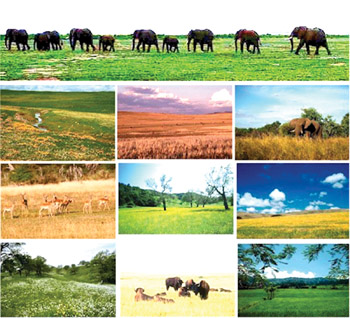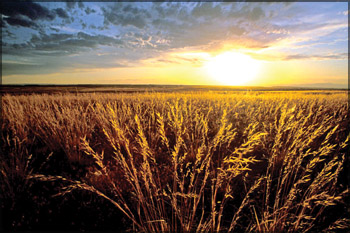|

Land dominated by grasses
If you have been reading
this page the last few weeks, you may know that we have been featuring
the different biomes of the world. Today, we feature the grassland
biome.
Grasslands can be defined as lands dominated by grasses rather than
large shrubs or trees. There are two main categories of grasslands -
Tropical grasslands or savannahs and Temperate grasslands.
Savannah
Savannah is grassland with scattered individual trees. Savannahs
cover almost half the surface of Africa, large areas of Australia, South America and India.
areas of Australia, South America and India.
The climate is the most important factor in creating a savannah.
Savannahs are always found in warm or hot climates where the annual
rainfall is about 50.8-127 cm (20-50 inches) per year.
It is crucial (important) that the rainfall is concentrated to six or
eight months of the year, followed by a long period of drought. If the
rain was well distributed throughout the year, many such areas would
become tropical forests.
Savannahs which result from climatic conditions are called
climatic savannahs. Savannahs
that are caused by soil conditions and that are not entirely maintained
by fire are called
edaphic savannahs.
These can occur on hills or ridges where the soil is shallow, or in
valleys where clay soils become waterlogged in wet weather. A third type
of savannah, known as derived savannahs,
is the result of people clearing forest land for cultivation.
In Africa, a heavy concentration of elephants in a protected parkland
have created a savannah by eating leaves and twigs, breaking off the
branches, smashing the trunks and stripping the bark of trees. Elephants
can convert dense woodland into open grassland in a short period of
time. Annual fires then maintain the area as a savannah.
The soil of the savannah is spongy, with rapid drainage of water. It
has only a thin layer of humus (the organic portion of the soil created
by partial decomposition [break-up] of plant or animal matter), which
provides vegetation with nutrients. Savannahs are sometimes classified
as forests.
Different savannahs support different grasses due to differences in
rainfall and soil conditions. Because the savannah supports such a large
number of species competing for living space, usually, only one or a few
kinds of grass are more successful than the others in a particular area.
For example, in drier savannahs such as those on the Serengeti plains or
Kenya's Laikipia plateau, the dominant grasses on well-drained soils are
Rhodes grass and red oat grass.
Savannahs have both a dry and a rainy season. Seasonal fires play a
vital role in their biodiversity. In October, a series of violent
thunderstorms, followed by a strong drying wind, signal the beginning of
the dry season.
During March, violent thunderstorms occur again, this time signing
the rainy season. When the rains come, savannah bunch grasses grow
vigorously(flourishingly). Some of the larger grasses grow an inch or
more within 24 hours.
The savannahs experience a surge (sudden increase) of new life at
this time. For example, many antelope calves are born. With so much
grass to feed on, their mothers have plenty of milk.
The calves die if the rains fail to come. Other animals (all which
may not occur in the same savannah) include giraffes, zebras, buffaloes,
kangaroos, mice, moles, gophers, ground squirrels, snakes, worms,
termites, beetles, lions, leopards, hyenas and elephants.
There are also some environmental concerns regarding savannahs such
as clearing of the land for crops.
Temperate grassland
Temperate grasslands are characterised as having grasses as the
dominant vegetation. Trees and large shrubs are absent.
Temperate grasslands can be further subdivided.
Prairies are grasslands with
tall grasses while steppes
are grasslands with short grasses. Prairie and steppes are somewhat
similar.
Temperatures vary more from summer to winter, and the amount of
rainfall is less in temperate grasslands than in savannahs. The major examples are the Veldts of South Africa,
the Puszta of Hungary, the Pampas of Argentina and Uruguay, the Steppes
of the former Soviet Union, and the plains and prairies of central North
America. The amount of annual rainfall influences the height of
grassland vegetation, with taller grasses in wetter regions.
than in savannahs. The major examples are the Veldts of South Africa,
the Puszta of Hungary, the Pampas of Argentina and Uruguay, the Steppes
of the former Soviet Union, and the plains and prairies of central North
America. The amount of annual rainfall influences the height of
grassland vegetation, with taller grasses in wetter regions.
As in the savannah, seasonal drought and occasional fires are very
important to biodiversity. However, their effects aren't as dramatic in
temperate grasslands as they are in savannahs.
The soil of the temperate grasslands is deep and dark, with fertile
upper layers. It is nutrient-rich from the growth and decay of deep,
many-branched grass roots. The rotted roots hold the soil together and
provide a food source for living plants.
Each different species of grass grows best in a particular grassland
environment (determined by temperature, rainfall and soil conditions).
The various species of grasses include purple needle grass, blue grama,
buffalo grass and galleta. Flowers include asters, blazing stars,
coneflowers, goldenrods, sunflowers, clovers, psoraleas and wild
indigos.
The fauna (which do not all occur in the same temperate grassland)
include gazelles, zebras, rhinoceroses, wild horses, lions, wolves,
prairie dogs, jack rabbits, deer, mice, coyotes, foxes, skunks, badgers,
blackbirds, grouses, meadowlarks, quails, sparrows, hawks, owls, snakes,
grasshoppers, leafhoppers and spiders.
There are also environmental concerns regarding the temperate
grasslands. Few natural prairie regions remain now because most have
been turned into farms or grazing land. This is because they are flat,
treeless, covered with grass and have rich soil.
Compiled by Janani Amarasekara |
